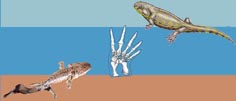Tetrapod World: early evolution and diversification
Discovering how tetrapods splashed out!
The TW:eed Project was an NERC-funded scientific research programme studying fossils and environments from the Early Carboniferous Tournaisian Stage, roughly 350 million years ago. Teams of experts from the Universities of Cambridge, Leicester and Southampton, the British Geological Survey and National Museums of Scotland collaborated to study some spectacular recently-discovered fossils which filled a significant gap (Romer's Gap) in our understanding of how tetrapods moved from water onto land, the other animals and plants that existed at that time, and the environment in which these changes took place.
The project consisted of teams working on the palaeontology, sedimentology, stratigraphy, palynology and performing stable isotope analysis, so that we could discover not only how tetrapods became terrestrial, but also what the environment, plants and other animals were like and how they changed in parallel with the tetrapods.
We also worked with experts in a number of other universities and institutions, both in the UK and abroad. Please see the Project Partners and Canadian Partners pages.
Our project blog is at www.tetrapodworld.com , but is no longer maintained. The Project Facebook page is also rather static these days.
-
This project is over, the funding has run out and the team effectively dispersed. The work continues, of course, but I won't be updating this website in future.
I'm very sorry to have to announce that Project Leader, Professor Jenny Clack, died in Addenbrooke's Hospital, Cambridge, after a 5-year battle with cancer, in March, 2020. She was working on a joint paper the week before she died. This paper has now been submitted for publication.


